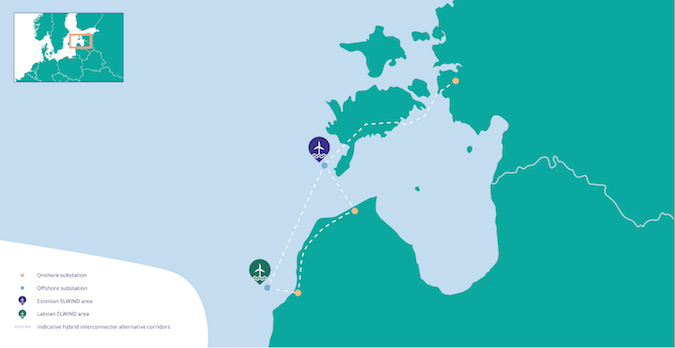In the 2nd article in our series on the Baltic States, this article takes a look at a prominent offshore wind development called ELWIND. When you look at the global offshore renewable map there is an extensive amount of wind development in the North Sea. However, if you take a look further east, offshore wind development appears to be growing near the Baltic states with multiple areas being planned for offshore wind development. Of these developments, ELWIND may be the most prominent. ELWIND is a joint Estonian and Latvian state run, cross border offshore wind development. It will potentially act as a catalyst and template for further development within the Baltic States (Estonia, Latvia, and Lithuania). The aim of ELWIND is to ‘raise energy independence in the region by increasing production of green energy and improving interstate electricity connectivity’. ELWIND has the potential for 3 terawatt-hours of renewable energy every year, which is about 1/5th of the total energy consumption of Estonia and Latvia (at 16 terawatt-hours). Under current timescales ELWIND is planned to be operational by 2030 [1].
Figure 1: ELWIND development area. [2]
What is the Project timeline?
The ELWIND project has set the following timelines:
- MoU (Memorandum of Understanding) 2020
- Technical assistance 2021
- Pre-feasibility study 2021
- C-B RES list nomination 2022
- Final area decisions 2022
- CEF RES application 2023
- EIA (Environmental Impact Assessment) 2025 – Current Stage.
- Auction 2026
- Project construction 2028+
- Commissioning 2030+
Why is the ELWIND project needed?
The ELWIND project and similarly the harmony link (a proposed grid connection between Lithuania and Estonia) forms part of geopolitical strategy of energy integration and security with the EU and away from Russia. This is especially important given the ongoing war between Ukraine and Russia.
‘A project like ELWIND is now even more important than before. The new geopolitical and energy market reality, the urgency of climate change, and the Russian war against Ukraine require the EU to drastically accelerate the green energy transition and increase Europe’s energy independence from unreliable suppliers and fossil fuels faster. For Estonia and Latvia, local competitive and green energy production has become a matter of national security more than ever.’[3]
What aviation or radar constraints could a wind development pose?
In general, wind developments can potentially act as an obstruction risk for pilots and this safety concern can potentially act as a restriction on the height of any proposed turbines. Radar can also be effected, this is predominately due to the effect of ‘clutter’ whereby the spinning of the turbines appear as moving objects on the air traffic controllers screen (which is informed by the radar data). This can be confused with aircraft. Furthermore, there is the potential for a shadowing effect whereby the area behind the turbines relative to the radar can no longer pick up information regarding what aircraft are present.
The position in Estonia and Latvia regarding military radar may be positive. In response to whether the ELWIND project will affect national defence, the following is stated on the official website:
ESTONIA
‘Definitely not. This means Estonia will invest around €70 million in various systems to ensure that wind parks no longer interfere with radars. At present, almost 85% of the Estonian mainland is still subject to height restrictions imposed by the defence forces for the construction of wind parks, in addition to nature conservation restrictions.The radar limitations will be not an issue for offshore wind parks in Riga Bay after these investments have been made. There are no conflicts with military radar interaction on ELWIND Estonian wind park area.’
LATVIA
‘Latvia is currently looking into the options on how to upgrade the defence technology, shall such a need arise from developing wind parks. One of the possibilities would be introducing a compensation mechanism as set out in the annotation of the respective draft law. In this case, each project would be assessed on a case-by-case basis by the Ministry of Defence to determine the concrete needs. After the assessment, the technically most appropriate and economically most viable solution would be selected, the amount of expenditure determined and paid in accordance with a written agreement setting out the form and modalities of the eventual compensation.’
Conclusions
The ELWIND project will not be a stand alone for offshore wind development in the Baltic States. For example there is also the Saare-Liivi wind development of the west coast of Estonia located near Parnu, Kihnu, and Ruhnu and set to be completed by 2028 [4]. The first stage of the Saare-Liivi wind development will consist of approximately 80 wind turbines with a total capacity of 1,200 MW (annual electricity production of about 5 TWh). The potential for these wind developments to promote future development in the Baltic States is significant.
Pager Power
Pager Power has worked on wind projects in the Baltic States with respect to aviation and radar safety. Pager Power is a dedicated technical consultancy that has been providing independent guidance and advice regarding wind farms and aviation safety internationally since 2002. Pager Power has completed over 1,000 aviation/radar impact assessments.
If you require assistance on aviation/radar issues for one of your projects, please get in touch on our website or call us on +44 (0)1787 319001.
References
[1] https://elwindoffshore.eu/
[2] https://elwindoffshore.eu/elwind/#elwind-et
[3] https://elwindoffshore.eu/elwind/#elwind-et
[4] https://saareliivituulepark.ee/en/
Thumbnail image accreditation: Usinspa (2015), ‘Latviešu: Offshore Windpark ‘ from Wikicommons.com. Last accessed on 4th January 2023. Available at: https://commons.wikimedia.org/wiki/File:Blade_hd.jpg




